Up Up and Away: Commercial Drone Market Ready for Take Off
, Posted in: Inspiration, Author: nleavitt (August 30, 2014)
Drone proponents prefer using the term Unmanned Aerial Vehicle (UAV) or UAS for Unmanned Aerial System (latter term includes the entirety of the flying vehicle and the ground-base communications connection connecting the two). Whatever your preferred verbiage is, drones are poised to become a huge global business and the aerial devices are going to have a significant impact across a wide variety of industries.
Historically, the military has been the biggest user/purchaser of drones; The Wall Street Journal estimated that the U.S. military spent about $3 billion on drone programs in 2012. And many aerospace companies continue to develop highly sophisticated machines that are lightweight and easy to assemble/launch.
Columbus, MS-based Stark Aerospace, for instance, recently rolled out ArrowLite™, a small UAS system that supports the U.S. Army Hunter MQ-5B UAS. It weighs less than 7 lbs. and can be assembled and hand-launched in less than 90 seconds.
Looking beyond the military, commercial drones will soon take on much larger roles for businesses and even for individual consumers. BI Intelligence, a research service from Business Insider, estimates that 12% of an estimated $98 billion in cumulative global spending on aerial drones over the next decade will be for commercial purposes. And the San Jose Mercury-News reported that in 2013, there were 15 venture investment deals in drones worth about $79 million. Key players include Andreeson Horowitz (one example – a $10 million investment they made in Airware, which makes software and systems that control drones) and Google Ventures.
“This technology is an extra tool to help an industry be more effective,” said Gretchen West, executive vice president for the Association for Unmanned Vehicle Systems International (AUVSI). “With precision agriculture, for example, it can take pictures of fields so farmers can identify problems they wouldn’t necessarily see walking through the woods. In law enforcement, you can find a child lost in the woods more easily than walking through a field, particularly if there’s bad weather or treacherous ground”
In fact, AUVSI predicts commercial drones could pump almost $14 billion into the U.S. economy between 2015-2018, and over a 10-year period, create more than 100,000 new jobs, including 34,000 in manufacturing.
But there’s a speed bump right now, at least in the United States. The Federal Aviation Administration (FAA) hasn’t yet legalized commercial drone usage, although it’s expected this will change sometime next year. Meanwhile, West estimates the U.S. is losing $10 billion annually.
“A lot of countries are allowing for flight, and that puts us at a disadvantage,” said West. “We’re seeing U.S. manufacturers realize they’re developing great products they can’t use here, and they’re looking to overseas to fulfill their business model.”
“This market’s going to be huge,” said Ken Loo, a Sunnyvale, CA mechanical engineer who used a 3D printer to create his own UAV. “The possibilities are endless. I know so many people getting into this field now so that they can pounce once the FAA comes up with its rules.”
But it won’t be easy for the FAA. Michael Blades is an analyst with market research firm Frost & Sullivan; he follows the commercial drone market.
“The airspaces in Australia and Brazil, for instance, aren’t nearly as crowded as ours. And the first time one of these unmanned vehicles accidentally takes down a plane, the FAA will be torn apart. So the rule-making process is tricky, because in a way, the sky is a political battleground,” said Blades.
Companies like Google and Amazon aren’t waiting around. Google’s advanced research lab, Google X, announced last week that it’s developing a system of drones to deliver goods. The Wall Street Journal reported that a five-foot wide single-wing prototype from Google’s Project Wing carried supplies including candy bars, dog treats, cattle vaccines, water and radios to two farmers in Queensland, Australia earlier this month. Amazon introduced drone prototypes last year and has asked the FAA for permission to test them in open U.S. airspace; a decision is pending.
The potential commercial uses are endless. Drones have been used in both the U.S. and Canadian real estate markets for more than a year. Vancity Buzz reported that two Vancouver brothers – Jordan and Russ McNab, use a $3,000 ‘quadcopter’ drone to shoot videos of larger homes and mansions to help move properties for their family real estate business. Every time they use the drone, they have to obtain a special flight operations certificate from Transport Canada.
“There are limitations to how high and how close you can fly to things and people,” said Jordan McNab. “For interior shots, we even need to submit a flight plan for the route the quadcopter will take inside a home.”
Some other innovative uses for the aerial devices:
• Last year a team of engineers in California launched the ‘Burrito Bomber,’ a UAV that uses GPS coordinates to drop burritos by parachute;
• David Bird, a professor of wildlife biology at McGill University in Canada, uses a UAV to count birds and polar bears;
• The University of South Dakota is using a drone to capture appealing outdoor shots to help market its Vermillion campus;
• Dave Anderson, who heads up Dana Point, CA-based Captain Dave’s Whale Watching & Dolphin Safari, uses two video-equipped drones to shoot footage of whales and dolphins off the Pacific coast. His first drone video garnered more than eight million YouTube views and has helped boost business.
We’re just on the cusp of seeing this industry explode. Christian Sanz, founder and CEO of drone startup Skycatch
 summed it up:
summed it up:
“Far from being insidious, airborne peeping toms, drones can be a boon to a host of businesses, from real estate to mining to energy and beyond. They have the potential to add value to our society.”
Comments